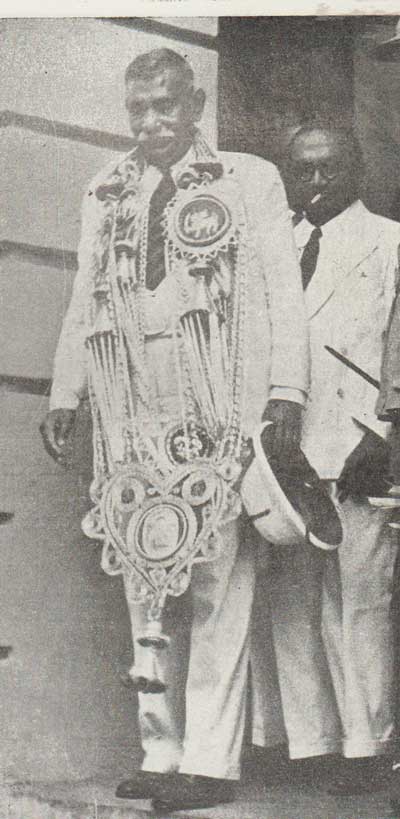Wednesday Jan 07, 2026
Wednesday Jan 07, 2026
Saturday, 17 October 2015 00:00 - - {{hitsCtrl.values.hits}}

D.S. Senanayake after winning the Mirigama seat
A milestone in the history of parliamentary system of government in Sri Lanka was recorded this week. It happened 68 years ago.
The inaugural meeting of the House of Representatives in the First Parliament was held on 14 October 1947. On this day 101 Members of Parliament (MPs) met at the then State Council building opposite the sea at Galle Face – the building that houses the Presidential Secretariat today.
Of the 101 MPs, 95 were elected by the people from 89 electorates (four were multi-member constituencies – three electing two members each and the other three members) and six appointed by the Governor who represented the monarch of Great Britain.
The general election was held over a period of 19 days between 23 August and 20 September 1947. Candidates contested from political parties for the first time. As leader of the party winning the highest number of seats (42), the leader of the United National Party (UNP), Don Stephen Senanayake was invited by Governor Sir Monk Mason Moore to form the government. Though the UNP did not have an absolute majority, Senanayake got the support of the All Ceylon Tamil Congress (seven MPs) and a few other members. He was sworn in as Prime Minister on 24 September.
A 14-member Cabinet was also sworn in on the same day. The ministers were:
Nine Parliamentary Secretaries (as Junior/Deputy Ministers were then known) were also appointed. They were: Simon Abeywickrema (Transport), P.B. Bulankulame (Agriculture and Lands), George R. de Silva (Justice), A.E. Goonesinghe (Labour), M.A. Ismail (Food), A.P. Jayasuriya (Posts), M.S. Kariapper (Home Affairs), V. Nalliah (Health) and H. de Z Siriwardena (Industries).
The Cabinet office was established as a separate department with Deputy Secretary to the Treasury, T.D. Perera as its head (designated Secretary to the Cabinet) while holding his substantive post.
At the first meeting of Parliament, UNP member for Balangoda, A.F. Molamure was elected Speaker after a contest with the Opposition candidate H. Sri Nissanka (Ind-Kurunegala) 58-41. Molamure was speaker in the first State Council in 1931.
S.W.R.D. Bandaranaike was named Leader of the House and Dr. N.M. Perera became Leader of the Opposition as the leader of the party, Lanka Sama Samaja Party (LSSP), with the second highest number of seats. The LSSP won 10 seats.
Leaders of seven parties out of nine that contested the election won their seats. They were: D.S. Senanayake (UNP – Mirigama), Dr. N.M. Perera (LSSP – Ruwanwella), G.G. Pommambalam (Tamil Congress – Jaffna), Dr. Colvin R. de Silva (Bolshevik Leninist Party – Wellawatte/Galkissa), Pieter Keuneman (Communist Party – Colombo Central), S. Thondaman (Ceylon Indian Congress – Nuwara Eliya) and A.E. Goonesinghe (Labour Party – Colombo Central).
S.W.R.D. Bandaranaike won the Attanagalla seat with a record majority of 26,854 votes. Among other party stalwarts who won were J.R. Jayewardene (UNP – Kelaniya), J.L. Kotelawela (UNP – Dodangaslanda), T.B. Jayah (UNP – Colombo Central), George E. de Silva (UNP – Kandy), Dudley Senanayake (UNP – Dedigama), Philip Gunawardena (LSSP – Avissawella) and Robert Gunawardena (LSSP – Kotte).